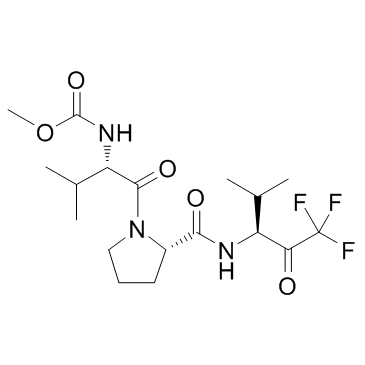182073-77-4
| Name | ZD8321 |
|---|---|
| Synonyms |
T7FIA2S66D
L-Prolinamide, N-(methoxycarbonyl)-L-valyl-N-[(1S)-3,3,3-trifluoro-1-(1-methylethyl)-2-oxopropyl]- N-(methoxycarbonyl)-L-valyl-N-[(3S)-1,1,1-trifluoro-4-methyl-2-oxopentan-3-yl]-L-prolinamide N-(Methoxycarbonyl)-L-valyl-N-[(3S)-1,1,1-trifluoro-4-methyl-2-oxo-3-pentanyl]-L-prolinamide |
| Description | ZD8321 is a potent inhibitor of human Neutrophil elastase (NE) with a Ki of 13±1.7 nM. |
|---|---|
| Related Catalog | |
| Target |
Ki: 13±1.7 nM (Neutrophil elastase)[1] |
| In Vitro | TNFα-activated HUVEC is dose dependently inhibited by ZD8321.The adhesion between cancer cells with high elastase activity and TNFα-activated HUVEC is also inhibited by ZD8321. Expression of cell surface E-selectin by NE stimulation is suppressed in the presence of ZD8321. The concentration of soluble E-selectin in the medium increases after adhesive reaction between neutrophils and HUVEC. This increase is also dose dependently inhibited by ZD8321[2]. |
| Cell Assay | HUVECs are cultured in RPMI 1640 containing 5% FBS for 6 h in collagen-coated, 24-well plates before the experiment. Some of the confluent HUVECs are further incubated with TNFα (1 ng/mL) and ZD8321 (0-50 mM), or with human NE (0-100ng/mL) for 4 h at 37°C. For adhesion assays, cancer cells resuspended in RPMI 1640 containing 5% FBS are added to each HUVEC-layered well. The plates are shaken at 700 rpm for 10 min at room temperature, washed twice with PBS, and examined by phase-contrast microscopy to determine the number of cells bound onto the HUVEC monolayer. The adhesive reactions of neutrophils to HUVEC are also analyzed in this manner[2]. |
| References |
| Density | 1.2±0.1 g/cm3 |
|---|---|
| Boiling Point | 573.9±50.0 °C at 760 mmHg |
| Molecular Formula | C18H28F3N3O5 |
| Molecular Weight | 423.427 |
| Flash Point | 300.9±30.1 °C |
| Exact Mass | 423.198120 |
| LogP | 3.26 |
| Vapour Pressure | 0.0±1.6 mmHg at 25°C |
| Index of Refraction | 1.471 |
| Storage condition | 2-8℃ |
